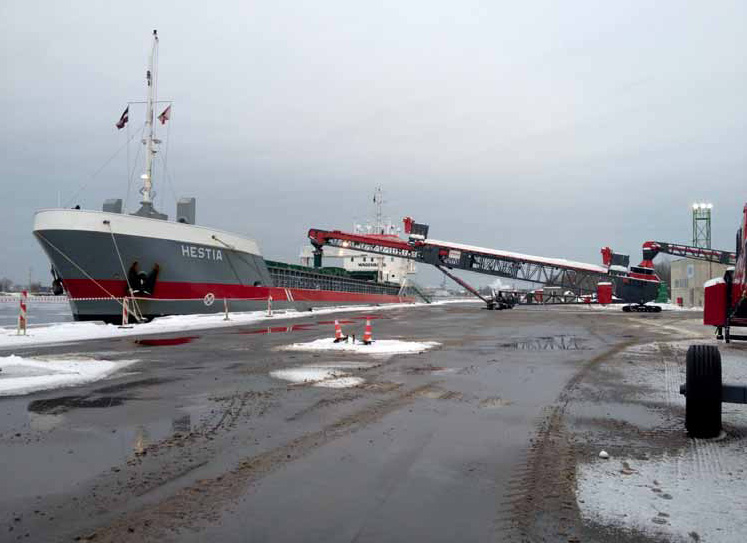
Telestack materials transfer & shiploading system for Riga Fertilizer Terminal
Telestack has recently installed and commissioned a mobile materials transfer and shiploading system for Riga Fertilizer Terminal (RFT) in Latvia. The transshipment terminal, when completed at the end of 2014, will be the most advanced and safest handling facility for fertilizer in Northern Europe.
The material is brought by rail from Russia via RFT’s partner Uralchem. The rail wagons are then unloaded and transferred by a series of conveyors to covered dome storage, each with a capacity of 25,000 tonnes. Telestack was involved in this project to supply custom design mobile feeding/material transfer/ shiploading solutions for the Phase One of the project. This system has enabled the company to export fertilizers before the complete project is finished, hence enabling it to have a revenue stream before complete construction is finished. The Telestack system will be used for the first three years as the main shiploader and, after this period, will be used as supplementary capacity and back-up for fixed installation.
THE TELESTACK SYSTEM
Due to the proximity of the terminal to the city of Riga, the complete system incorporated fully covered conveyors and fully sealed transfer points as well as dust extraction to minimize dust emissions into the nearby environment. This was paramount in the facility being granted permission to export from the terminal, and was something that was foremost in Telestack’s design brief.
The material is reclaimed from the dome storage via two Liebherr 576 wheel loaders. These feed the material into a Telestack HF514 mobile hopper feeder, which has a 15m3 capacity with a 1,200mm-wide belt feeder. The hopper is fully lined with 6mm polyurethane liners to minimize wear and protect the paint finish. The feeder and incline conveyor speeds are controlled by a variable-speed drive. This is required as RFT will handle a variety of materials with densities ranging from 0.7t/ m3 to 1.4t/m3. The variable-speed drive also enables the operator to run the belt speeds as slow as possible so as to minimize dust creation at transfer points.
After the hopper feeder, the material is then transferred to a series of Telestack 30-metre mobile link conveyors. These link conveyors are wheel mounted and can be manoeuvred around the site by a wheel loader. The link conveyors also incorporate a dust extraction system at each transfer point. Telestack used Donaldson Torit, an internationally recognized manufacturer of quality extraction systems. The filter element used on the extraction unit was made up of a special neoprene fabric which is suitable with use for fertilizers. The extraction systems also featured a intelligent automated monitoring system which maintained efficiency of the units.
The extraction units were supplied with pneumatic air by means of a 150-litre compressor mounted on each link conveyor. The link conveyors also featured a variable speed drive to control the belt speeds. As with all the transfer points, the link conveyors utilized the fully enclosed chutes both at discharge points and at the intake point.
The final Telestack mobile link conveyor also had a radial drive incorporated into the wheels which enabled the unit to radial 45° of centre line, so as to feed the shiploader at two positions to load each hatch on an 8,000dwt coaster vessel. This enabled a quick set up time for the hatch changes.
The Telestack Mobile shiploader supplied to RFT is a custom- design TS 542 (500tph [tonnes per hour] at a 42-metre maximum extension). The unit incorporates complete dust extraction and containment features, some of which include fully sealed transfer points, fully covered conveyors both on the inner and the outer, dust extraction and transfer points, complete under trays to prevent material dropping onto the jetty and an 8.5-metre freefall chute to contain the dust right into the ship’s hold.
The TS 542 is crawler tracked mounted and is fully mobile to move from hatch to hatch. The crawler tracks also have rubber pads to protect the concrete structure of the jetty. The telescopic, luffing and radial ability enabled RFT to completely trim the 8,000dwt vessel from the two loading positions.
The Telestack mobile solution of RFT is easily moved around the terminal as required giving RFT significant flexibility.
Due to the corrosive nature of the fertilizer, a very high paint specification has been used on all machines with average dry film thickness of 250 micron 2 pak epoxy paint finish. The complete system is powered by RFT’s mains electricity which enables very low operating costs for the complete system.
The system complies with environmental dust pollution regulations. Maris Rudzitis, engineering manager commented that he is very satisfied with the attention to detail, the quality of the construction and the timely delivery of the equipment. “The system has proved very reliable and we are very happy with our purchase. Telestack’s ability to guide us through concept stage to the right solution and customize a system to our individual specific requirements was a major factor why we awarded Telestack the contract,” he says.
Telestack offers a range of mobile bulk material handling solutions which are in operation across the globe handling materials such as coal, iron ore, aggregates, fertilizer, grain etc in mines, ports, quarries, power plants, steel mills and cement kilns.